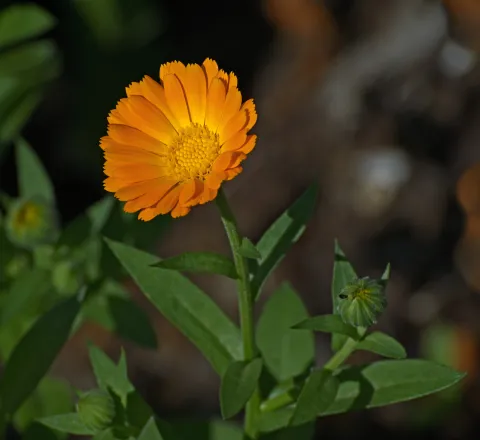
Scientific Name
Calendula officinalis
General Information
Calendula is beautiful, easy to grow, and deer resistant. Both leaves and petals are edible and have a peppery, tangy taste. Its yellow, orange, and gold flowers close in the dark and in wet weather but bloom through fall and into early winter in cool climates. It is a Mediterranean plant belonging to the Astereceae family.
When to Plant
From seed: Sow directly in the garden in early spring. Dead head regularly to increase bloom.
Transplants: Can be bought as a transplant. Plant this cool season plant in early spring. Plant height varies by variety.
Cuttings: While you can grow calendula from cuttings, planting by seed is the preferred way. It is so easy and calendula self-sows; plant once and it’s likely you never have to plant again.
Planting
Plant in early spring in full or part sun in a pot or directly in the ground. Survives cool, foggy, coastal summers.
Soil Requirements
Tolerates most soil as long as it is well-drained. It can also tolerate poor soil, including clay.
Water Requirements
Low water
Fertilizing
Not necessary
Pollination
Calendula is pollinated by bees and can also self-pollinate. It attracts bees and butterflies.
Harvesting
Flowers can be harvested, dried, and placed in a glass jar.
Storage
Dried flowers can be stored in a glass jar until next year’s harvest. Fill jar with olive oil and let sit for several weeks, then strain flowers from oil.
Good Varieties for Marin
There are many varieties of Calendula. Tall varieties make great cut flowers. ‘Flashback Mix’ produces tall cream to yellow to orange blooms. ‘Calypso Orange’ is compact with orange blooms. ‘Erfurter Orangefarbigen’ is grown commercially in Europe for its medicinal value. ‘Pacific Beauty’ is dependable and blooms are orange or yellow.
Helpful Tips
Calendula readily reseeds. Dead head mature flowers to control spread. Calendula fades in extreme heat but can be cut back when it goes limp and will likely bloom again in fall. There are heat-resistant cultivars for hot summer locales.
Common Problems
Powdery mildew can occur. Hose plants off with water and cut out as necessary.
Pests- Diseases & More
Calendula is susceptible to cucumber mosaic virus, in which case the plant should be removed and destroyed.

